Abstract
The field of statistical extreme value theory (EVT) focuses on estimating parameters associated with extreme events, such as the probability of exceeding a high threshold or determining a high quantile that lies at or beyond the observed data range. Typically, the assumption for univariate data analysis is that the sample is complete, independent, identically distributed, or weakly dependent and stationary, drawn from an unknown distribution F. However, in the context of lifetime data, censoring is a common issue. In this work, we consider the case of random censoring for data with a heavy-tailed, Pareto-type distribution. As is common in applications of EVT, the estimation of the extreme value index (EVI) is critical, as it quantifies the tail heaviness of the distribution. The EVI has been extensively studied in the literature. Here, we discuss several classical EVI-estimators and reduced-bias (RB) EVI-estimators within a semi-parametric framework, with a focus on RB EVI-estimators derived from generalized means, which will be applied to both simulated and real survival data.
1. Introduction and Preliminaries
The primary focus of statistical extreme value theory (EVT) is the estimation of parameters related to extreme events. In EVT, a common assumption for any univariate dataset is that the data form a complete sample of size n, which may be independent, identically distributed, or weakly dependent and stationary, drawn from an unknown cumulative distribution function (CDF) . A key parameter of interest is the unknown extreme value index (EVI), denoted by , which will be defined later. The estimation of the EVI forms the foundation for estimating all other extreme value parameters. An extended literature review is provided in Appendix A, including a few books on this topic.
When examining extreme events, particularly focusing on large values in the right tail, several key parameters are of interest:
- (a)
- The probability of exceedance for a high threshold , defined as .
- (b)
- A high quantile corresponding to a probability , where q is small, which is located at or beyond the range of the observed data. It is given bywith representing the generalized inverse function of F.
- (c)
- The right endpoint of the underlying distribution F, denoted .
In the analysis of lifetime or reliability data, observations are often censored, frequently in a random manner. In this context, we will focus specifically on estimating the extreme value index (EVI), , under conditions of random censoring and for a heavy Pareto-type regularly varying right tail function:
where is a slowly varying function at infinity, i.e., such that , for all (see, among others, Bingham, Goldie and Teugels [1], for details on regular and slow variation). A brief reference to the subject can be found in Reiss and Thomas [2], First Edition (see Section 6.1 of [2]). We further mention a few initial articles on the topic (Beirlant, Guillou, Dierckx and Fils-Viletard [3], Einmahl, Fils-Viletard and Guillou [4], Beirlant, Guillou and Toulemonde [5], and Gomes and Neves [6,7]). Additional references can be found in Appendix A.
In the context of random censoring, we consider a random variable Y such that, instead of observing X directly, we only observe
where denotes the indicator function of the set A. The indicator variable indicates whether X has been censored.
Within this framework, semi-parametric EVI-estimators require only minor adjustments to ensure consistency in estimating across parametric, semi-parametric, or even nonparametric settings.
We shall give special attention to such estimation for heavy tails, i.e., for , making use of several generalized means (GM) EVI-estimators (see Gomes and Martins [8], Brilhante, Gomes and Pestana [9] and Penalva, Gomes, Caeiro and Neves [10], among others), which generalize the classical Hill EVI-estimator (Hill [11]), and of one of the most simple minimum-variance reduced-bias (MVRB) estimators—the one in the work of Caeiro, Gomes, and Pestana [12]. We further consider RB-GM EVI-estimators, which will be detailed in Appendix B. For additional GM EVI-estimators, see Paulauskas and Vaičiulis’ study [13] and the recent overview article by Fedotenkov [14].
After a brief introduction in Section 2 regarding the notion of EVI and the most relevant first- and second-order conditions in statistical EVT, under a semi-parametric framework, we advance, in Section 3, with the functional definition of some of the already-mentioned EVI-estimators for complete samples and a heavy right tail, i.e., a positive EVI (see also, Appendix B).
The EVI-estimation under random censoring for the Pareto-type right tails in (2) is the main novelty of this article and will be addressed in Section 4. We shall apply the methodology to simulated data in Section 5, and to a set of survival data related to cancer of the tongue in Section 6, providing some hints for the adequate estimation of the EVI of X, the patient survival lifetime after detection of illness. A few overall comments and intentions of future work are provided in Section 7.
2. The Extreme Value Index (EVI)
The EVI quantifies the heaviness of the right tail of an underlying distribution F, for large values, and is extensively documented in the literature. Specifically, the EVI corresponds to the parameter in the general extreme value (GEV) cumulative distribution function (CDF), given by
The GEV CDF, in (4), also known as the von Mises–Jenkinson CDF (see von Mises [15] and Jenkinson [16]), represents the limiting distribution of a sequence of linearly normalized maximum values, provided that a non-degenerate limit exists (Fréchet [17], Fisher and Tippett [18], von Mises [15], Gnedenko [19], and de Haan [20]). When this condition holds, we say that the distribution F belongs to the domain of attraction of , denoted by . The EVI, , plays a crucial role in determining the behaviour of the right tail : for ; the right tail is light and F has a finite right endpoint (). For , the right tail is heavy with a negative polynomial decay, and F has an infinite right endpoint; when , the right tail exhibits an exponential decay, and the right endpoint can be either finite or infinite. The literature associated with the maximum likelihood (ML) estimation of in the GEV model, , with given in (4), and and , respectively location and scale parameters, can be found in the final paragraph of Appendix A.
First- and Second-Order Conditions in EVT
The following extended regular variation property (de Haan [21]) is a well-known necessary and sufficient condition for :
for every and some positive measurable function a, with U standing for a quantile-type function associated with F and defined by
Note that the upper-quantile in (1) can be defined as , with defined in (6). In addition to the first-order condition in (5), a second-order condition is often required to describe the rate of convergence in the first-order condition. A more restrictive assumption than involves the existence of a function A, which may not change sign and approaches zero as , such that
for all , where is a second-order parameter that governs the rate of convergence of the maximum values, normalized linearly, toward the EV limit distribution. In this context, is regularly varying with a variation index equal to (see Geluk and de Haan [22] and de Haan and Stadtmuller [23]). A slightly more restrictive assumption is that , , and that we can select in the general second-order condition, as described in (7), placing this within Hall and Welsh’s class of models [24].
3. EVI-Estimation for Complete Samples
In all applications of EVT, the EVI-estimation is of primordial importance. For a complete random sample , and heavy Pareto-type right tails, i.e., whenever , in (4), we first mention the classical Hill (H) estimator in [11], with the functional expression
where denotes the ascending-order statistics (OS) associated with the sample . And several generalizations of the Hill EVI-estimator, some of them referred in the following, are now available.
Different GM EVI-estimators were considered around the year 2000 to estimate a positive EVI, also called the tail index, under a semi-parametric framework. Among them, we mention the power mean (PM) of exponent p of the log-excesses, introduced in Gomes and Martins [25], and further studied in [8] and in Segers [26]. Those PM EVI-estimators are valid for a positive EVI, and are defined by
with denoting the complete Gamma function, and where
are the moments of order-p of the log-excesses, , defined in (8). For more recent GM EVI-estimators, also considered in the simulation studies of Section 5, see Appendix B.
3.1. A Few Comments on Reduced-Bias (RB) EVI-Estimation
Besides the GM EVI-estimators discussed previously in (9), and also the ones presented in Appendix B, various classes of RB EVI-estimators are also considered in this article. These classes rely on accurately estimating the second-order parameter vector in the function , in (7). Methods for effectively estimating are detailed in Gomes and Pestana [27], and more recent classes of and estimators (referenced in Caeiro, Gomes, Beirlant and De Wet [28]) are also promising candidates for estimating . Estimation should be conducted at a high-level , with and with , where denotes the integer part of x.
For heavy right tails, we mention one of the most relevant and simple MVRB estimators of (see [12]), given by
where are adequate consistent estimators of the vector of second-order parameters. For an algorithm related to such estimation and application to the estimation of high quantiles, which was already defined in (1), see [27], and also Caeiro and Gomes [29], among others. Additional RB-GM EVI-estimators, generalizing the MVRB EVI-estimators, in (11), are provided in Appendix B.
3.2. Semi-Parametric Asymptotic Behaviour of EVI-Estimators
For the aforementioned EVI-estimators, as well as for other EVI-estimators, and in the lines of de Haan and Peng [30], we can prove consistency in the whole , i.e., whenever (5) holds, with , provided that k is intermediate, i.e.,
Under the additional validity of the second-order condition, in (7), and with ⊙ denoting any of the aforementioned GM EVI-estimators, including the H EVI-estimators, in (8), we can guarantee asymptotic normality of , i.e., there exists a standard normal RV and real functions and , such that
4. EVI-Estimation under Random Censorship
In all articles mentioned in Section 3, the available sample is complete. Let us now assume that we are under a framework of random censorship, i.e., we have access to the sample , , of independent copies of , in (3), but our goal is to make inference on the right tail of the unknown lifetime distribution , i.e., we want to make inference on the right tail,
while , the CDF of Y, is considered to be a nonparametric nuisance parameter. As mentioned in [4], among others, all EVI-estimators need to then be modified in order to be consistent for the estimation of in the whole domain of attraction, . We shall next motivate a possible and simple modification.
A Few Comments on Random Censoring
Let us assume that , with as the parameter we want to estimate, and that , (heavy right tails). Also, instead of the potential sample (non-observed), and assuming Y is independent of X, we observe
Example 1.
To motivate how to estimate , we shall simplify the problem, assuming that X and Y are indeed Pareto and Pareto , respectively, i.e., for all , and . Then,
i.e., , and we can use the common semi-parametric estimators to estimate . On the other hand,
Then, the quotient between any estimator of and an estimator of will provide an estimator of .
Example 2.
Another key model in EVT is the generalized Pareto (GP) model, associated with excesses over a high threshold (see Balkema and de Haan [31] and Pickands [32]), and given by , with defined in (4). The ML-estimation of for a model , , is numerically hardly tractable. ML estimates for the regular-case and , in , have been studied in Smith [33], where the POT approach was introduced, with POT standing for peaks-over-threshold. A survey of the POT methodology, together with several applications, can be found in Davison and Smith [34]. Under random censoring, let us assume that for all , and . We then obtain
and
The abovementioned limiting result, at the end of Example 2, holds generally, for any , . Indeed, under the above general setting, in (13), and as can be seen in [4], it is possible to prove that
Note that
are Pareto-type right tails, already mentioned in (2). Since the CDF of is , we obtain
i.e., (15) holds.
Consequently, any functional devised for the semi-parametric estimation of the tail index in complete samples associated with the observed sample and based on the upper OS in the sample, generically denoted as , will converge towards in (15) for intermediate k, i.e., whenever (12) holds. Moreover, and for the same intermediate sequences k,
Consequently, we only need to find an estimator of in (14) with , the percentage of censoring in the right tail of . A possible semi-parametric consistent estimator of c (for intermediate k) is
where are the induced or concomitant OS associated with the ascending ordering of , i.e., is the concomitant value of associated with , . An obvious semi-parametric estimator of , based on the observed , is thus
an estimator already studied in [6,7], for a few estimation procedures.
The final estimate associated with will be computed using Algorithm 4.5. in [29], which we next summarize:
- (i)
- Given the observed sample and , compute, for , the observed values of , in (17).
- (ii)
- Obtain , the minimum value of j, a non-negative integer, such that the rounded values, to j decimal places, of the estimates in (i) are distinct. Define , , the rounded values of to j decimal places;
- (iii)
- Consider the sets of k values associated with equal consecutive values of , obtained in (ii). Set and the minimum and maximum values, respectively, of the set with the largest range. The largest run size is then .
- (iv)
- Consider all those estimates, , , now with two extra decimal places, i.e., compute . Obtain the mode of those estimates and denote by the set of k-values associated with this mode.
- (v)
- Take as the maximum value of .
- (vi)
- Compute .
We have applied this methodology to simulated random censored data in Section 5, as well as real survival data in Section 6, but even before showing the obtained results, we provide some general hints for the adequate EVI-estimation. For heavy right tails, i.e., a positive EVI, we strongly advise the use of any of the MVRB tail index estimators, like the one studied in [12]. GM EVI-estimators can also provide an interesting solution to the problem, and even a better solution can be obtained via RB GM EVI-estimators, the ones considered in this article.
5. Monte-Carlo Simulation
We have considered , with censored by , with , . Then, , with . Consequently, we allow for a percentage of censoring in the right tail equal to values that change from 65% to 5%.
For heavy right tails, we have performed a large-scale Monte Carlo simulation for different parents. Here, we consider the following:
- X and Y both come from Fréchet models (the CDF of a Fréchet model is , , ( and )).
- X and Y both come from Burr models (the CDF of a Burr model is , , , and ).
- X and Y both come from GP models (the CDF of a GP model is given in Example 2 ( and )).
For simplicity, the GM EVI-estimators in (9), (A1) and (A2) will be denoted by PM, MO and L, respectively, and the RB GM EVI-estimators in (A3), (A4) and (A5) by RBPM, RBMO and RBL, respectively.
In Figure 1 and Figure 2, for a sample size , we can see the mean values and the root-mean-squared errors (RMSEs) of some of the estimators under study when we consider
We then obtain for the observed Z a tail index . The censoring in the right tail is thus equal to .
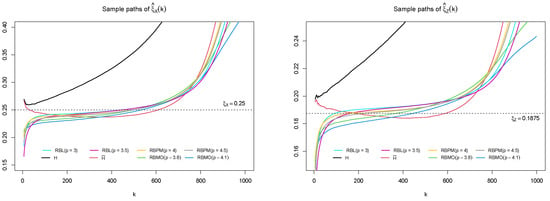
Figure 1.
Sample paths of (on the left) and of (on the right) for samples of size 1000 from the Fréchet parents under study.
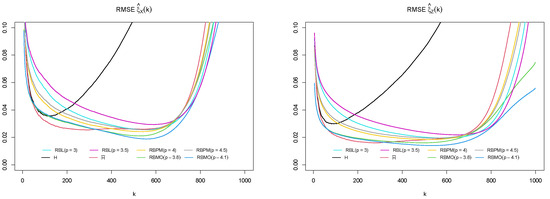
Figure 2.
RMSEs of (on the left) and of (on the right) for samples of size 1000 from the Fréchet parents under study.
Even for sample sizes as small as , from the same parents, the results are still interesting, as can be seen in Figure 3 and Figure 4. This generally happens if the censoring in the right tail is not too heavy (smaller than or equal to 25%, for example).
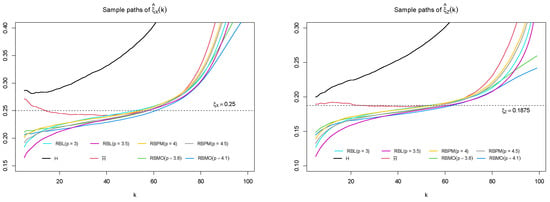
Figure 3.
Sample paths of (on the left) and of (on the right) for samples of size 100 from the Fréchet parents under study.
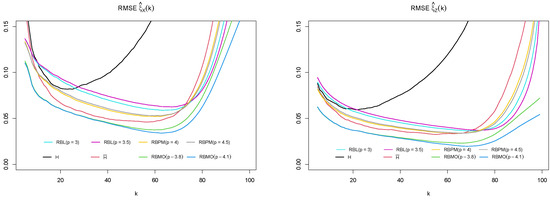
Figure 4.
RMSEs of (on the left) and of (on the right) for samples of size 100 from the Fréchet parents under study.
The sample paths and MSE of are presented in Figure 5. From this figure, we can infer that, for both sample sizes, the bias remains very small, up to 70% of the sample size.

Figure 5.
Sample paths of based on 1000 replicates of samples of size 100 (on the left) and samples of size 1000 (on the right) from the Fréchet parents under study.
Figure 6 and Figure 7 depict, for a sample size of , the mean values and RMSEs of the estimators under study when we consider
and, in this case, we obtain for the observed Z a tail index . The censoring in the right tail is thus equal to .
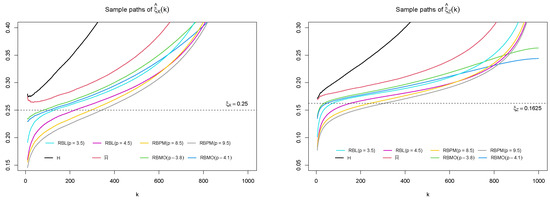
Figure 6.
Sample paths of (on the left) and of (on the right) for samples of size 1000 from the Burr parents under study.
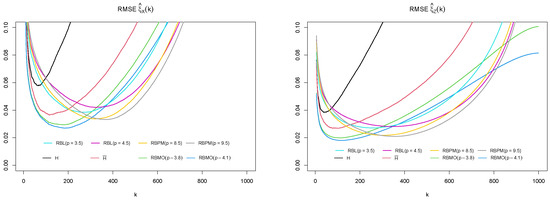
Figure 7.
RMSEs of (on the left) and of (on the right) for samples of size 1000 from the Burr parents under study.
For the Burr models, the estimates in (16) exhibit patterns similar to the ones presented in Figure 5 and are presented in Figure 8. As expected, when the censoring in the right tail increases, the k-region where the bias remains very small decreases, and in this case, it is up to 55% of the sample size.
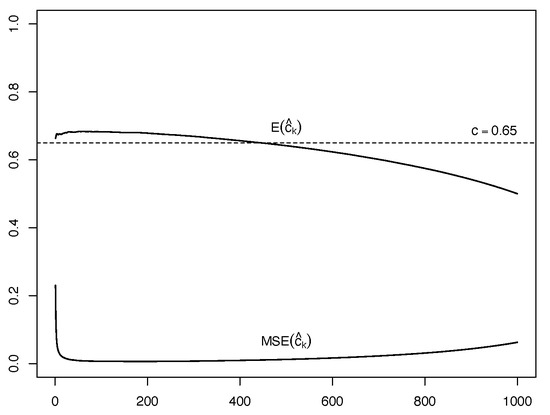
Figure 8.
Sample paths of based on 1000 replicates of samples of size 1000 from the Burr parents under study.
Figure 9 and Figure 10 depict, for a sample size of , the mean values and RMSEs of the estimators under study when we consider
and in this case, we obtain for the observed Z a tail index . The censoring in the right tail is thus equal to . An interesting feature of the GP model is that the use of GM EVI-estimators results in stable sample paths around the true values of and , eliminating the need for RB estimation.
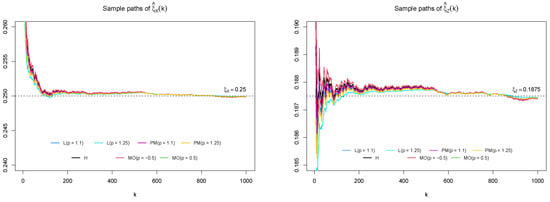
Figure 9.
Sample paths of (on the left) and of (on the right) for samples of size 1000 from the GP parents under study.
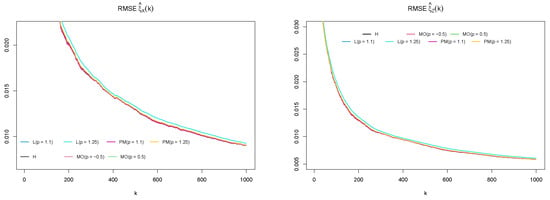
Figure 10.
RMSE of (on the left) and of (on the right) for samples of size 1000 from the GP parents under study.
The sample paths and MSE of are presented in Figure 11. We can infer from this figure that the bias is practically zero for all k, with .
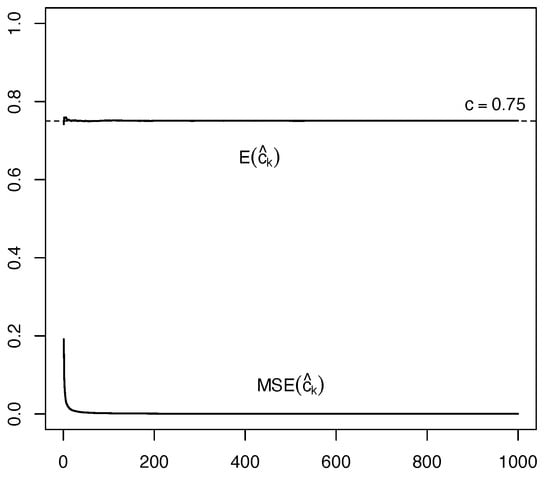
Figure 11.
Sample paths of based on 1000 replicates of samples of 1000 from the GP parents under study.
Based on these figures, we can draw the following conclusions:
- For an appropriate choice of p, the GM estimators of outperform the Hill EVI-estimator in terms of bias for the Fréchet, Burr and GP models under study.
- Once again, for an adequate choice of p, the GM estimators of outperform the MVRB EVI-estimator in terms of bias for a wide range of k-values, which depend on both the estimator and the value of the tuning parameter p, for the Fréchet, Burr and GP models under study.
- For the Fréchet and Burr models, all RB GM estimators of exhibit an even better solution, again for adequate choices of p.
- For the GP models under study, the use of the classic GM estimators is more efficient than the use of its RB versions.
- It is also worth noting that for the GP models under study, all GM estimators exhibit similar behaviour to the Hill estimator.
6. Lifetime Data Analysis (Cancer of the Tongue)
We herein consider data on 80 males diagnosed with cancer of the tongue, with Z denoting time to death or on-study time, in weeks (Section 1.11 in Sickle-Santanello et al. [35], available in Klein and Moeschberger [36] and in the package KMsurv, version 0.1-5, from the  software [37]. Data are available through the link, https://www.rdocumentation.org/packages/KMsurv/versions/0.1-5/topics/tongue (accessed on 21 April 2024)).
software [37]. Data are available through the link, https://www.rdocumentation.org/packages/KMsurv/versions/0.1-5/topics/tongue (accessed on 21 April 2024)).
 software [37]. Data are available through the link, https://www.rdocumentation.org/packages/KMsurv/versions/0.1-5/topics/tongue (accessed on 21 April 2024)).
software [37]. Data are available through the link, https://www.rdocumentation.org/packages/KMsurv/versions/0.1-5/topics/tongue (accessed on 21 April 2024)).The estimates of c as a function of k, the number of top OS used in the estimation, with the estimate marked by the dashed line, computed using an adapted version of Algorithm 4.5 in [29], which was already summarized in Section 4, are shown in Figure 12. On the basis of the stability criteria described above, we obtain the estimate for the parameter . We thus have a reasonably high censoring in the right tail, around 60%, and this makes the estimation of parameters of large events slightly problematic.
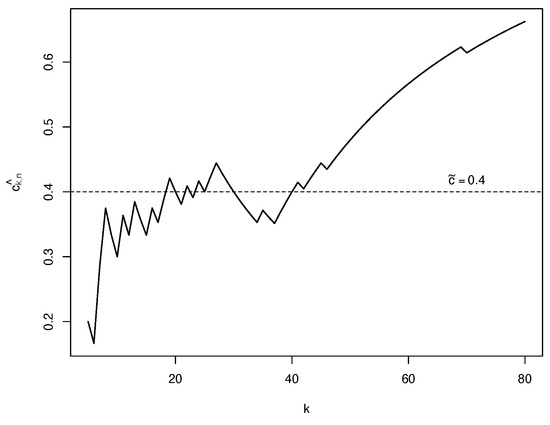
Figure 12.
Sample path of and adaptive estimate for the tongue cancer data.
We shall next provide estimates for and estimates for . For , the use of any of the EVI-estimators under consideration, devised for complete samples, based on the stability criteria above led us to the adaptive estimates presented in Table 1. The median of the RB GM EVI-estimators is , and considering the RB EVI-estimators under study, we obtain an overall median estimate of (depicted by the dashed line in Figure 13 (right)). The corresponding estimate of is then , also depicted by the dashed line in Figure 13 (left). As expected, the use of RB EVI-estimators allows for a significant reduction in bias compared to the classic EVI-estimator.

Table 1.
Adaptive estimates of the EVI-estimators under study for the tongue cancer data.
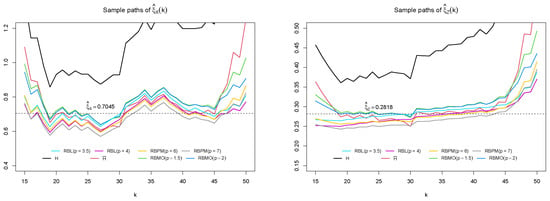
Figure 13.
Sample paths of (on the left) and of (on the right) for the tongue cancer data.
7. Overall Comments and Future Work
On the basis of the aforementioned results, the estimation of other parameters of extreme events like the probability of exceedance of a high level or a high quantile easily follow, but will be not discussed here. The development of new estimators of is a topic that deserves further study, but is also out of the scope of this paper. The interesting behaviour of the MOp and RB MOp estimators for values of p close to and its almost non-degenerate and consistent behaviour for deserves further attention, in the direction of the developments made by Gomes, Henriques-Rodrigues and Pestana [38], among others. Just as with complete samples, RB GM estimation provides a better solution for the estimation of parameters of rare events under random censorship. Apart from the algorithm considered herein for the estimation of the tuning parameter , several other algorithms (see, among others, Gomes, Caeiro, Henriques-Rodrigues and Manjunath [39], where R-scripts are provided) can be used and compared—a topic also out of the scope of this paper, such as the consideration of this type of RB GM estimation for a general .
Author Contributions
Conceptualization, M.I.G., L.H.-R., M.M.N. and H.P.; Methodology, M.I.G., L.H.-R., M.M.N. and H.P.; Software, L.H.-R., M.M.N. and H.P.; Validation, M.I.G., L.H.-R., M.M.N. and H.P.; Formal analysis, M.I.G.; Investigation, M.I.G., L.H.-R., M.M.N. and H.P.; Writing—original draft, M.I.G., L.H.-R., M.M.N. and H.P.; Writing—review and editing, M.I.G., L.H.-R., M.M.N. and H.P.; Visualization, L.H.-R., M.M.N. and H.P.; Supervision, M.I.G.; Project administration, M.I.G.; Funding acquisition, M.I.G. and L.H.-R. All authors have read and agreed to the published version of the manuscript.
Funding
This work was funded by national funds through the FCT—Fundação para a Ciência e a Tecnologia, I.P., under the scope of the project UIDB/00006/2020 (https://doi.org/10.54499/UIDB/00006/2020) (CEAUL) and project UIDB/MAT/04674/2020 (https://doi.org/10.54499/UIDB/04674/2020) (CIMA). The first and second authors are also financed, respectively, by HiTEc Cost Action
CA21163 and by project 10.54499/CEECINST/00054/2018/CP1522/CT0003 (https://doi.org/10.54499/CEECINST/00054/2018/CP1522/CT0003).
Institutional Review Board Statement
Not applicable.
Informed Consent Statement
Not applicable.
Data Availability Statement
Data used in this article are based on simulated and open datasets and can be obtained from the corresponding author upon request.
Conflicts of Interest
The authors declare no conflicts of interest.
Abbreviations
The following abbreviations are used in this manuscript:
| CDF | cumulative distribution function |
| EVI | extreme value index |
| EVT | extreme value theory |
| GEV | general extreme value |
| GM | generalized means |
| GP | generalized Pareto |
| H | Hill |
| L | Lehmer |
| ML | maximum likelihood |
| MO | mean of order |
| MSE | mean squared error |
| MVRB | minimum-variance reduced-bias |
| OS | order statistics |
| PM | power mean |
| RB | reduced-bias |
| RMSE | root-mean-squared error |
| RV | random variable |
Appendix A. Extended Literature Review
For interested readers, among other books on the topic of EVT, including [2], that are already mentioned, we refer the following ones, in an ascending chronological order: Gumbel [40], Castillo [41], Beirlant, Teugels and Vynckier [42], Embrechts, Klüppelberg and Mikosch [43], Tiago de Oliveira [44], Kotz and Nadarajah [45], Coles [46], Beirlant, Goegebeur, Segers and Teugels [47], Castillo, Hadi, Balakrishnan and Sarabia [48], de Haan and Ferreira [49], Resnick [50], Markovich [51], Gomes, Fraga-Alves and Neves [52], Balakrishnan and Cohen [53].
Regarding random censorship, a few additional and more recent references on the estimation of EV parameters are next chronologically provided: Ndao, Diop and Dupuy [54,55], J Worms and R Worms [56,57,58], Brahimi, Meraghni and Necir [59], Benchaira, Meraghni and Necir [60], Stupfler [61,62], Beirlant, J Worms and R Worms [63], Goegebeur, Guillou and Qin [64], Haouas, Necir and Brahimi [65], Bladt, Albrecher and Beirlant [66], Escobar-Bach and Van Keilegom [67], Bladt and Rodionov [68], Diop and Deme [69]. Further details on random censorship can be found in the books by Mann, Schafer and Singpurwalla [70], by Maller and Zhou [71] and by Bagdonavicius, Kruopis and Nikulin [72], among others.
Under a parametric framework, and whenever dealing with maximum values, the ML estimators of in the EV model, i.e., , with given in (4), and , respectively location and scale parameters, can be found in Prescott and Walden [73,74], Hosking [75], Smith [76] and Macleod [77], among others.
Appendix B. Additional GM EVI-Estimators for Complete Samples
Notice that the Hill EVI-estimators, in (8), as means of the k excesses of the logarithm of the ordered observations, can be considered as geometric means, or equivalently, a means of order , of the set of core statistics:
Instead of such a geometric mean, and after the development of some preliminary publications on the subject, the authors of [9], and almost simultaneously, Paulauskas and Vaičiulis [78] and Beran, Schell and Stehlík [79], considered in a more general way the mean of order (MOp) of these statistics. Note that it is further possible to consider (see [28]) and the class of MOp EVI-estimators,
with , the Hill EVI-estimators, in (8).
We further refer to Lehmer (L) EVI-estimators,
where and are, respectively, given in (8) and in (10) (see [10], among others).
Following the recent work of Henriques-Rodrigues, Caeiro and Gomes [80], where an RB version of the PMk,n,p was introduced in (9), we shall work with the RB PMp EVI-estimators,
with , in (11).
References
- Bingham, N.H.; Goldie, C.M.; Teugels, J.L. Regular Variation; Cambridge University Press: Cambridge, MA, USA, 1987. [Google Scholar] [CrossRef]
- Reiss, R.-D.; Thomas, M. Statistical Analysis of Extreme Values with Applications to Insurance, Finance, Hydrology and Other Fields, 3rd ed.; Birkhaüser: Berlin, Germany, 2007. [Google Scholar]
- Beirlant, J.; Guillou, A.; Dierckx, G.; Fils-Viletard, A. Estimation of the extreme value index and extreme quantiles under random censoring. Extremes 2007, 10, 151–174. [Google Scholar] [CrossRef]
- Einmahl, J.H.J.; Fils-Villetard, A.; Guillou, A. Statistics of extremes under random censoring. Bernoulli 2008, 14, 207–227. [Google Scholar] [CrossRef]
- Beirlant, J.; Guillou, A.; Toulemonde, G. Peaks-Over-Threshold modeling under random censoring. Commun. Stat.—Theory Methods 2010, 39, 1158–1179. [Google Scholar] [CrossRef]
- Gomes, M.I.; Neves, M.M. A note on statistics of extremes for censoring schemes on a heavy right tail. In Proceedings of the ITI 2010, 32nd International Conference on Information Technology Interfaces, Cavtat, Croatia, 21–24 June 2010; Luzar-Siffler, V., Jarec, I., Bekic, Z., Eds.; SRCE University Computing Centre Editions. IEEE: Cavtat, Croatia, 2010; pp. 539–544. [Google Scholar]
- Gomes, M.I.; Neves, M.M. Estimation of the extreme value index for randomly censored data. Biomet. Lett. 2011, 48, 1–22. [Google Scholar]
- Gomes, M.I.; Martins, M.J. Generalizations of the Hill estimator—Asymptotic versus finite sample behaviour. J. Stat. Plan. Inference 2001, 93, 161–180. [Google Scholar] [CrossRef]
- Brilhante, M.F.; Gomes, M.I.; Pestana, D. A simple generalization of the Hill estimator. Comput. Stat. Data Anal. 2013, 57, 518–535. [Google Scholar] [CrossRef]
- Penalva, H.; Gomes, M.I.; Caeiro, F.; Neves, M.M. A couple of non-reduced bias generalized means in extreme value theory: An asymptotic comparison. Rev.—Stat. J. 2020, 18, 281–298. [Google Scholar] [CrossRef]
- Hill, B.M. A simple general approach to inference about the tail of a distribution. Ann. Stat. 1975, 3, 1163–1174. [Google Scholar] [CrossRef]
- Caeiro, F.; Gomes, M.I.; Pestana, D. Direct reduction of bias of the classical Hill estimator. Rev.—Stat. J. 2005, 3, 113–136. [Google Scholar] [CrossRef]
- Paulauskas, V.; Vaičiulis, M. A class of new tail index estimators. Ann. Inst. Stat. Math. 2017, 69, 461–487. [Google Scholar] [CrossRef]
- Fedotenkov, I. A Review of More than One Hundred Pareto-Tail Index Estimators. Statistica 2020, 80, 245–299. [Google Scholar] [CrossRef]
- von Mises, R. La distribution la plus grande de n valeurs. Rev. Math. Union Interbalcanique 1936, 1, 141–160, Erratum in Sel. Pap. Richard von Mises Am. Math. Soc. 1964, 2, 271–294.. [Google Scholar]
- Jenkinson, A.F. The frequency distribution of the annual maximum (or minimum) values of meteorological elements. Q. J. R. Meteorol. Soc. 1955, 81, 158–171. [Google Scholar] [CrossRef]
- Fréchet, M. Sur la loi de probabilité de l’écart maximum. Ann. Soc. Pol. Math. 1927, 6, 93–116. [Google Scholar]
- Fisher, R.A.; Tippett, L.H.C. Limiting forms of the frequency of the largest or smallest member of a sample. Proc. Camb. Philos. Soc. 1928, 24, 180–190. [Google Scholar] [CrossRef]
- Gnedenko, B.V. Sur la distribution limite du terme maximum d’une série aléatoire. Ann. Math. 1943, 44, 423–453. [Google Scholar] [CrossRef]
- de Haan, L. On Regular Variation and Its Application to the Weak Convergence of Sample Extremes; Mathematical Centre Tract 32: Amsterdam, The Netherlands, 1970. [Google Scholar]
- de Haan, L. Slow variation and characterization of domains of attraction. In Statistical Extremes and Applications; de Oliveira, T., Ed.; D. Reidel: Dordrecht, The Netherlands, 1984; pp. 31–48. [Google Scholar] [CrossRef]
- Geluk, J.; de Haan, L. Regular Variation, Extensions and Tauberian Theorems; CWI Tract 40; Center for Mathematics and Computer Science: Amsterdam, The Netherlands, 1987. [Google Scholar]
- de Haan, L.; Stadtmueller, U. Generalized regular variation of second order. J. Aust. Math. Soc. Ser. A 1996, 61, 381–395. [Google Scholar] [CrossRef]
- Hall, P.; Welsh, A.W. Adaptive estimates of parameters of regular variation. Ann. Stat. 1985, 13, 331–341. [Google Scholar] [CrossRef]
- Gomes, M.I.; Martins, M.J. Efficient alternatives to the Hill estimator. In Extreme Values and Additive Laws; Gomes, M.I., Pestana, D., Canto e Castro, L., Fraga Alves, M.I., Martins, M.J., Eds.; CEAUL Editions: Lisboa, Portugal, 1999; pp. 40–43. [Google Scholar]
- Segers, J. Residual estimators. J. Stat. Plan. Inference 2001, 98, 15–27. [Google Scholar] [CrossRef]
- Gomes, M.I.; Pestana, D. A sturdy reduced-bias extreme quantile (VaR) estimator. J. Am. Stat. Assoc. 2007, 102, 280–292. [Google Scholar] [CrossRef]
- Caeiro, F.; Gomes, M.I.; Beirlant, J.; de Wet, T. Mean-of-order-p reduced-bias extreme value index estimation under a third-order framework. Extremes 2016, 19, 561–589. [Google Scholar] [CrossRef]
- Caeiro, F.; Gomes, M.I. Threshold selection in extreme value analysis. In Extreme Value Modeling and Risk Analysis: Methods and Applications; Dey, D., Yan, J., Eds.; Chapman-Hall/CRC: Boca Raton, FL, USA, 2016; pp. 69–87. [Google Scholar]
- de Haan, L.; Peng, L. Comparison of extreme value index estimators. Stat. Neerl. 1998, 52, 60–70. [Google Scholar] [CrossRef]
- Balkema, A.A.; de Haan, L. Residual life time at great age. Ann. Probab. 1974, 2, 792–804. [Google Scholar] [CrossRef]
- Pickands, J., III. Statistical inference using extreme order statistics. Ann. Stat. 1975, 3, 119–131. [Google Scholar]
- Smith, R.L. Estimating tails of probability distributions. Ann. Stat. 1987, 15, 1174–1207. [Google Scholar] [CrossRef]
- Davison, A.C.; Smith, R.L. Models for exceedances over high thresholds. J. R. Stat. Soc. Ser. B—Stat. Methodol. 1990, 52, 393–442. [Google Scholar] [CrossRef]
- Sickle-Santanello, B.J.; Farrar, W.B.; DeCenzo, J.F.; Keyhani-Rofagha, S.; Klein, J.; Pearl, D.; Laufman, H.; O’Toole, R.V. Technical and statistical improvements for flow cytometric DNA analysis of paraffin-embedded tissue. Cytometry 1988, 9, 594–5999. [Google Scholar] [CrossRef] [PubMed]
- Klein, J.P.; Moeschberger, M.L. Datasets for Survival Analysis—Techniques for Censored and Truncated Data, 2nd ed.; Springer: Berlin, Germany, 2005. [Google Scholar]
- Original by Klein, Moeschberger and Modifications by Jun Yan. KMsurv: Data Sets from Klein and Moeschberger (1997), Survival Analysis, 2012, R Package Version 0.1-5. Available online: https://CRAN.R-project.org/package=KMsurv (accessed on 21 April 2024).
- Gomes, M.I.; Henriques-Rodrigues, L.; Pestana, D. Non-regular frameworks and the mean-of-order-p extreme value index estimation. J. Stat. Theory Pract. 2022, 16, 37. [Google Scholar] [CrossRef]
- Gomes, M.I.; Caeiro, F.; Henriques-Rodrigues, L.; Manjunath, B.G. Bootstrap methods in statistics of extremes. In Extreme Events in Finance: A Handbook of Extreme Value Theory and its Applications; Longin, F., Ed.; Handbook Series in Financial Engineering and Econometrics (Ruey Tsay Adv. Ed.); John Wiley & Sons: Hoboken, NJ, USA, 2016; Chapter 6; pp. 117–138. [Google Scholar] [CrossRef]
- Gumbel, E.J. Statistics of Extremes; Columbia University Press: New York, NY, USA, 1958. [Google Scholar]
- Castillo, E. Extreme Value Theory in Engineering; Academic Press: Cambridge, MA, USA; Elsevier: New York, NY, USA, 1988. [Google Scholar] [CrossRef]
- Beirlant, J.; Teugels, J.L.; Vynckier, P. Practical Analysis of Extremes; Leuven University Press: Leuven, Belgium, 1996. [Google Scholar]
- Embrechts, P.; Klüppelberg, C.; Mikosch, T. Modelling Extremal Events for Insurance and Finance; Springer: Berlin, Germany, 1997. [Google Scholar]
- Tiago de Oliveira, J. Statistical Analysis of Extremes; Pendor: Binghamton, NY, USA, 1997. [Google Scholar]
- Kotz, S.; Nadarajah, S. Extreme Value Distributions—Theory and Applications; Imperial College Press: London, UK, 2000. [Google Scholar]
- Coles, S. An Introduction to Statistical Modeling of Extreme Values; Springer: London, UK, 2001. [Google Scholar] [CrossRef]
- Beirlant, J.; Goegebeur, Y.; Segers, J.; Teugels, J. Statistics of Extremes. Theory and Applications; Wiley: Hoboken, NJ, USA, 2004. [Google Scholar] [CrossRef]
- Castillo, E.; Hadi, A.S.; Balakrishnan, N.; Sarabia, J.M. Extreme Value and Related Models with Applications in Engineering and Science; Wiley: Hoboken, NJ, USA, 2004. [Google Scholar]
- de Haan, L.; Ferreira, A. Extreme Value Theory: An Introduction; Springer Science+Business Media, LLC: New York, NY, USA, 2006. [Google Scholar]
- Resnick, S. Heavy-Tail Phenomena: Probabilistic and Statistical Modeling; Springer: New York, NY, USA, 2007. [Google Scholar]
- Markovich, N. Nonparametric Analysis of Univariate Heavy-Tailed Data: Research and Practice; Wiley: Hoboken, NJ, USA, 2007. [Google Scholar]
- Gomes, M.I.; Fraga-Alves, M.I.; Neves, C. Análise de Valores Extremos: Uma Introdução; SPE and INE Editions: Richardson, TX, USA, 2013. [Google Scholar]
- Balakrishnan, N.; Cohen, A.C. Order Statistics & Inference; Statistical Modeling and Decision Science; Academic Press: Cambridge, MA, USA, 2014. [Google Scholar]
- Ndao, P.; Diop, A.; Dupuy, J.-F. Nonparametric estimation of the conditional tail index and extreme quantiles under random censoring. Comput. Stat. Data Anal. 2014, 79, 63–79. [Google Scholar] [CrossRef]
- Ndao, P.; Diop, A.; Dupuy, J.F. Nonparametric estimation of the conditional extreme value index with random covariates and censoring. J. Stat. Plan. Inference 2016, 168, 20–37. [Google Scholar] [CrossRef]
- Worms, J.; Worms, R. New estimators of the extreme value index under random right censoring, for heavy-tailed distributions. Extremes 2014, 17, 337–358. [Google Scholar] [CrossRef]
- Worms, J.; Worms, R. A Lynden-Bell integral estimator for extremes of randomly truncated data. Stat. Prob. Lett. 2016, 109, 106–117. [Google Scholar] [CrossRef][Green Version]
- Worms, J.; Worms, R. (2018). Extreme value statistics for censored data with heavy tails under competing risks. Metrika 2018, 81, 849–889. [Google Scholar] [CrossRef]
- Brahimi, B.; Meraghni, D.; Necir, A. Gaussian approximation to the extreme value index estimator of a heavy-tailed distribution under random censoring. Math. Methods Stat. 2015, 24, 266–279. [Google Scholar] [CrossRef]
- Benchaira, S.; Meraghni, D.; Necir, A. Tail product-limit process for truncated data with application to extreme value index estimation. Extremes 2016, 19, 219–251. [Google Scholar] [CrossRef][Green Version]
- Stupfler, G. Estimating the conditional extreme-value index under random right-censoring. J. Multivar. Anal. 2016, 144, 1–24. [Google Scholar] [CrossRef]
- Stupfler, G. On the study of extremes with dependent random right-censoring. Extremes 2019, 22, 97–129. [Google Scholar] [CrossRef]
- Beirlant, J.; Worms, J.; Worms, R. Estimation of the extreme value index in a censorship framework: Asymptotic and finite sample behavior. J. Stat. Plan. Inference 2019, 202, 31–56. [Google Scholar] [CrossRef]
- Goegebeur, Y.; Guillou, A.; Qin, J. Bias-corrected estimation for conditional Pareto-type distributions with random right censoring. Extremes 2019, 22, 459–498. [Google Scholar] [CrossRef]
- Haouas, N.; Necir, A.; Brahimi, B. Estimating the second-order parameter of regular variation and bias reduction in tail index estimation under random truncation. J. Stat. Theory Pract. 2019, 13, 7. [Google Scholar] [CrossRef]
- Bladt, M.; Albrecher, H.; Beirlant, J. Trimmed extreme value estimators for censored heavy-tailed data. arXiv 2021, arXiv:2105.05523v1. [Google Scholar] [CrossRef]
- Escobar-Bach, M.; Van Keilegom, I. Nonparametric estimation of conditional cure models for heavy-tailed distributions and under insufficient follow-up. Comput. Stat. Data Anal. 2023, 183, 107728. [Google Scholar] [CrossRef]
- Bladt, M.; Rodionov, I. Censored Extreme Value Estimation. arXiv, 2024; arXiv:2312.10499. [Google Scholar]
- Diop, A.; Deme, E.H. A bias-reduced estimation for reinsurance risk premiums of heavy-tailed loss distributions under random truncation. Far East J. Theor. Stat. 2024, 68, 199–226. [Google Scholar] [CrossRef]
- Mann, N.R.; Schafer, R.E.; Singpurwalla, N.D. Methods for Statistical Analysis of Reliability and Life Data; Wiley: New York, NY, USA, 1975; ISBN 047156737X. [Google Scholar]
- Maller, R.A.; Zhou, X. Survival Analysis with Long-Term Survivors; John Wiley & Sons: Hoboken, NJ, USA, 1996. [Google Scholar]
- Bagdonavicius, V.; Kruopis, J.; Nikulin, M.S. Non-Parametric Tests for Censored Data; ISTE/WILEY: London, UK, 2011. [Google Scholar]
- Prescott, P.; Walden, A.T. Maximum likelihood estimation of the parameters of the generalized extreme-value distribution. Biometrika 1980, 67, 723–724. [Google Scholar] [CrossRef]
- Prescott, P.; Walden, A.T. Maximum likelihood estimation of the parameters of the three-parameter generalized extreme-value distribution from censored samples. J. Stat. Comput. Simul. 1983, 16, 241–250. [Google Scholar] [CrossRef]
- Hosking, J.R.M. Algorithm AS 215: Maximum likelihood estimation of the parameters of the generalized extreme value distribution. J. R. Stat. Soc. Ser. C Appl. Stat. 1985, 34, 301–310. [Google Scholar] [CrossRef]
- Smith, R.L. Maximum likelihood estimation in a class of nonregular cases. Biometrika 1985, 72, 67–90. [Google Scholar] [CrossRef]
- Macleod, A.J. A remark on the algorithm AS215: Maximum likelihood estimation of the parameters of the generalized extreme value distribution. Appl. Stat. 1989, 38, 198–199. [Google Scholar] [CrossRef]
- Paulauskas, V.; Vaičiulis, M. On an improvement of Hill and some other estimators. Lith. Math. J. 2013, 53, 336–355. [Google Scholar] [CrossRef]
- Beran, J.; Schell, D.; Stehlík, M. The harmonic moment tail index estimator: Asymptotic distribution and robustness. Ann. Inst. Stat. Math. 2014, 66, 193–220. [Google Scholar] [CrossRef]
- Henriques-Rodrigues, L.; Caeiro, F.; Gomes, M.I. A New Class of Reduced Bias Generalized Hill Estimators. Mathematics 2024, 12, 2866. [Google Scholar] [CrossRef]
- Gomes, M.I.; Brilhante, M.F.; Pestana, D. New reduced-bias estimators of a positive extreme value index. Commun. Stat.—Simul. Comput. 2016, 45, 833–862. [Google Scholar] [CrossRef]
- Gomes, M.I.; Penalva, H.; Caeiro, F.; Neves, M.M. Non-reduced versus reduced-bias estimators of the extreme value index-efficiency and robustness. In Proceedings of the COMPSTAT 2016—22nd International Conference on Computational Statistics, Oviedo, Spain, 23–26 August 2016; Colubi, A., Blanco, A., Gatu, C., Eds.; The International Statistical Institute/International Association for Statistical Computing: Den Hague, The Netherlands, 2016; pp. 279–290. [Google Scholar]
Disclaimer/Publisher’s Note: The statements, opinions and data contained in all publications are solely those of the individual author(s) and contributor(s) and not of MDPI and/or the editor(s). MDPI and/or the editor(s) disclaim responsibility for any injury to people or property resulting from any ideas, methods, instructions or products referred to in the content. |
© 2024 by the authors. Licensee MDPI, Basel, Switzerland. This article is an open access article distributed under the terms and conditions of the Creative Commons Attribution (CC BY) license (https://creativecommons.org/licenses/by/4.0/).